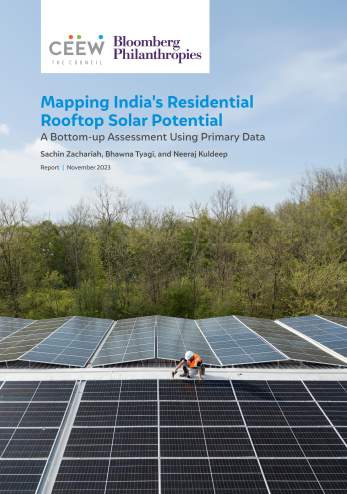



Suggested citation: MNRE and CEEW. 2024. Enabling a Circular Economy in India’s Solar Industry: Assessing the Solar Waste Quantum. New Delhi: Council on Energy, Environment and Water.
Transitioning from a linear to a circular approach in the solar PV industry will not only create effective waste management practices but also lead India toward a self-reliant and independent economy. The first step in achieving this is to assess the solar PV waste quantum in the country. This study proposes a novel coefficient-based waste estimation model to estimate the solar PV waste generated from existing and upcoming installations. It also identifies major waste producing regions across the country and the high economic value that can be obtained from the extraction of minerals from the waste PV modules.
The solar PV waste management process consisting of collection, transportation and recycling can also lead to the creation of employment opportunities. Hence, solar waste management is crucial from both resource management and socio-economic perspectives.
India needs around 292 GW of solar capacity by 2030 (CEA 2023). With the rapid deployment of solar photovoltaic (PV) technologies, concerns are building around solar waste management. Responsible solar PV waste management is critical for environmental, economic, and social reasons (Tyagi and Kuldeep, 2021). The discarded modules include minerals such as silicon, copper, tellurium, and cadmium, which have been classified as critical minerals for India by the Ministry of Mines (MoM 2023). Recycling solar waste to recover these materials will reduce import dependency and enhance India’s mineral security. The Ministry of Environment Forest and Climate Change (MoEFCC) recently amended the Electronic Waste (Management) Rules to include solar cells and modules in their ambit (MoEFCC 2022). The Ministry of New and Renewable Energy (MNRE) has also identified solar PV recycling as one of the priorities thrust areas under the Renewable Energy Research and Technology Development (RE-RTD) Programme (PIB 2023a).
A granular estimation of solar waste would help policymakers and industry players make informed decisions regarding the required regulations and infrastructure deployment. Although some studies provide estimates for India’s solar waste (IRENA and IEA-PVPS 2016, Suresh, Singhvi and Rustagi 2019), they rely on global databases to ascertain the waste at the end-of-life (EoL) of modules. A granular study that captures module degradation rates and replacement trends in Indian climatic conditions is crucial.
The study bridges the information gap in India-specific solar waste estimates by developing a comprehensive waste estimation model that provides the temporal and spatial distribution of solar waste. It further runs a comparative analysis across various scenarios by varying the module degradation rate and other available methodologies.
Figure ES1 67% of the cumulative waste in 2030 is expected to be originating from five states

Source: Authors’ analysis
Figure ES2 India’s cumulative solar waste will increase 32 times between 2030 and 2050

Source: Authors’ analysis
Solar waste refers to both discarded modules as well as scrap generated during the cell and module manufacturing processes. Modules can be discarded either when solar PV modules reach the end of their functional life or upon sustaining damages from activities such as transportation, handling and installation. Solar waste in India should be treated appropriately according to the Electronic Waste Management Rules 2022. Improper handling of solar waste and landfillings should be avoided to reclaim the valuable minerals from the waste and safeguard the environment from leaching of any toxic materials like lead and cadmium.
Yes. Solar waste can be recycled to recover materials like glass, aluminium, copper, silicon and silver. Recycling can be broadly categorised into mechanical, thermal and chemical processes. Each process helps in the recovery of specific minerals of varying purity grades.
The management of waste generated from solar PV modules, panels and cells is part of the Electronic Waste Management Rules 2022. The rules mandate solar PV module and cell producers to store the waste generated from solar PV modules and cells up to 2034 – 2035 as per the guidelines laid down by the Central Pollution Control Board (CPCB). The rules also mandate the filing of annual returns on the e-waste management portal up to 2034 – 2035. Every recycler of solar PV modules and cells shall be mandated for the recovery of materials as laid down by the CPCB.
Efficient management of solar waste requires a comprehensive regulatory framework guiding collection, recycling/reuse and material-specific recovery targets. It should also focus on promoting market linkages for the recovered materials and market mechanisms to facilitate solar waste management. Parallely, domestic efforts in research and development of recycling technologies need to be ramped up. Funding channels need to be created to promote such research and pilot demonstrations.
A granular estimation of solar waste will guide several business and policy decisions. This includes waste management infrastructure (such as number and location of collection and recycling facilities), collection and recycling targets for producers and recyclers, and business models for waste management.

Community Solar for Advancing Power Sector Reforms and the Net-Zero Goals

Mapping India’s Residential Rooftop Solar PotentialA bottom-up assessment using primary data

Promoting the Use of LPG for Household Cooking in Developing Countries